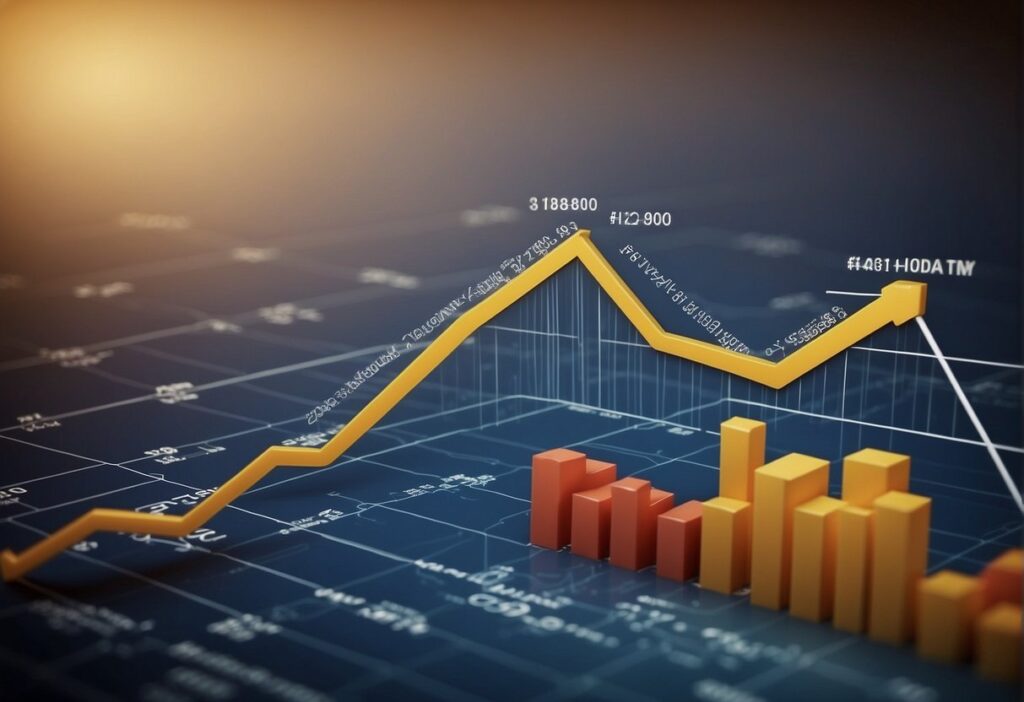
What is Stagflation? Explaining the Economic Phenomenon
Stagflation is an economic scenario marked by three adverse conditions: high inflation, high unemployment, and stagnant demand. This trifecta poses significant challenges as it defies traditional economic behavior.
Under normal circumstances, a booming economy leads to inflation, whereas a downturn dampens inflationary pressures. However, during periods of stagflation, this correlation breaks down, creating a complex problem for policymakers.
Understanding stagflation requires an analysis of its underlying causes, which can range from external shocks, such as oil price increases, to inappropriate monetary policies or a combination of multiple factors.
Its effects are far-reaching, impacting not only the economy but also the socio-political landscape in which it occurs. Stagflation’s rarity and severity make it a particularly notable phenomenon in economic history and discourse.
Responding to stagflation demands unconventional approaches, as standard fiscal and monetary tools can have counterproductive outcomes, like tightening the money supply, which could potentially increase unemployment further.
Key Takeaways
- Stagflation combines high inflation, high unemployment, and slow economic growth.
- It defies normal economic trends and presents unique challenges to policymakers.
- Addressing stagflation requires atypical and often innovative economic strategies.
Defining Stagflation

Economic Characteristics
- Inflation: Persistent increase in the prices of goods and services over time, eroding purchasing power. In a stagflationary period, inflation rates are high or rising.
- Unemployment: The unemployment level is significantly elevated as economic stagnation curtails business expansion and job creation.
- Stagnation: This refers to sluggish or no growth in economic output. During stagflation, an economy experiences flat or declining productivity and business activity.
Historical Context
Stagflation is not a common occurrence but rather an economic anomaly. It first became widely recognized during the 1970s when major industrial economies experienced it simultaneously. The oil price shocks during that era disrupted economies, leading to both inflationary pressures and a halt in economic growth.
As a result, the conventional belief was challenged, which held that inflation and unemployment could not rise concurrently, illustrating the divergent nature of stagflation from typical recessions.
Causes of Stagflation

The Role of Supply Shocks
Supply shocks play a central role in the onset of stagflation. They occur when there is a sudden and significant decrease in a commodity or service supply, with oil price shocks being a classic example.
An abrupt increase in oil prices limits production and increases costs across various industries, leading to both slowed economic growth and rising inflation rates.
Monetary Policy Factors
Monetary policy, often enacted by a central bank, significantly impacts economic stability. In some stagflation episodes, a central bank’s decision to increase the money supply in an attempt to simulate a sluggish economy can inadvertently result in higher inflation.
This occurs when the increased money supply does not align with the economy’s productivity, leading to a currency devaluation.
External Influences
External influences, including abandoning the gold standard and resulting currency fluctuations, also contribute to stagflation.
When currency value is no longer tied to a stable asset like gold, this can lead to increased volatility and uncertainty in the financial markets. The combination of these external pressures can aggravate the stagnation within the economy, pushing inflation to higher levels.
Effects and Implications

On the Economy
When stagflation grips the economy, growth slows down markedly. This sluggish growth often leads to a higher unemployment rate, increasing the number of people out of work while prices for goods and services continue to rise.
As inflation rates escalate, consumers’ purchasing power diminishes, leading to decreased consumer spending and confidence. Consequently, businesses may face lower sales, pressure on profit margins, and hurdles to investment, perpetuating the cycle of limited economic expansion.
For Policymakers
Due to its dual nature, policymakers find stagflation particularly challenging. Aggressive monetary policies, like increasing interest rates to curb inflation, can worsen unemployment by making borrowing more expensive and slowing down investment.
Meanwhile, expansionary fiscal policies stimulating the economy may inadvertently fuel inflation further. Policymakers must navigate this narrow path by implementing measures that can address both aspects without exacerbating either.
Impact on Population
The population endures the consequences of stagflation through the strain on household budgets and living standards. As the cost of living climbs due to rising inflation, wages often fail to keep up, effectively reducing real income.
Unemployment creates additional financial and psychological stress among families, reducing consumer sentiment and economic participation. The cumulative effect can lead to increased social strife and demands for government intervention to stabilize the economy and alleviate hardships.
Responses to Stagflation

Central Banks’ Approach
Central banks, like the Federal Reserve, typically respond to stagflation by carefully calibrating their monetary policies. These policies may involve rate hikes to dampen inflation.
However, such actions are taken with caution to avoid exacerbating economic stagnation. These rate adjustments are based on thorough economic analysis and forecasting models to balance curbing inflation and not hindering economic growth.
Government Economic Policy
In response to stagflation, governments might implement Keynesian economics principles, such as fiscal stimulus.
This involves increased government spending and reductions in taxes to boost aggregate demand. The aim is to foster job creation and economic activity without adding to inflationary pressures.
Alternative Strategies
Apart from orthodox approaches, alternative strategies can also be considered.
These might entail incentivizing productivity improvements and technological advancements to increase economic efficiency. Some suggest enhancing competitiveness through deregulation and promoting labor flexibility to address unemployment without generating inflationary pressures.
These alternative strategies complement traditional fiscal and monetary policies.
Key Figures and Events

Notable Economists
Paul Volcker is often associated with the fight against stagflation during the late 1970s and early 1980s. As the Chairman of the Federal Reserve, Volcker implemented aggressive interest rate hikes to curb the high inflation rates characteristic of stagflation.
Historic Economic Events
The Great Inflation was a period of sustained high inflation in the United States during the 1970s, which is a classic period of stagflation. The Bretton Woods system, established post-World War II, created an international monetary framework that collapsed in 1971 under President Richard Nixon.
Nixon’s suspension of dollar convertibility into gold contributed to the instability that led to stagflation. Additionally, during the 1973 oil crisis, the Organization of the Petroleum Exporting Countries (OPEC) dramatically raised oil prices, sharply increasing inflation and contributing to the stagflation environment.
Contemporary Relevance

Recent Examples
Recent economic trends have been marked by events such as the COVID-19 pandemic, which have rekindled concerns about stagflation.
The overheated economy, triggered by the influx of fiscal stimulus and pent-up demand post-pandemic, has raised alarms about potential stagflationary pressures.
For instance, the crisis witnessed a job market disruption while triggering a sharp rise in consumer prices, echoing the hallmarks of stagflation.
Modern Economic Challenges
Addressing stagflation involves navigating the complex economic cycle, where conventional tools might not be readily effective.
Experts like Jane Jacobs have long argued that modern economies are intricate organisms, thus requiring nuanced approaches to tackle such challenges.
Policymakers must now balance between stimulating growth and controlling inflation, which has grown challenging in the face of global health and financial shocks.
The interplay between these forces indicates that stagflation remains a critical concern in understanding and managing today’s economic conditions.
Economic Theories and Stagflation

Phillips Curve Analysis
The Phillips Curve posits an inverse relationship between inflation and unemployment. Traditionally, this economic model suggests that higher inflation is associated with lower unemployment and vice versa.
However, stagflation creates a conundrum, as it features both high inflation and high unemployment simultaneously, challenging economists to rethink the Phillips Curve utility in such circumstances.
Demand-Pull and Cost-Push Theories
Stagflation can be dissected further into demand-pull and cost-push inflation theories.
Demand-pull inflation occurs when the demand for goods and services exceeds supply, driving prices up.
In contrast, cost-push inflation is the result of increased costs of production or inputs like wages and raw materials, causing producers to raise prices to maintain profit margins.
Stagflation has been linked to cost-push factors, especially with historical events like oil price shocks that abruptly increase production costs across various sectors.
Global Perspective

Stagflation in Different Countries
In the United States, stagflation is characterized by a stagnant labor market and rising prices, which squeeze both consumers and producers.
Europe may experience stagflation differently due to its unique market dynamics and dependencies, such as those on energy imports, which can exacerbate inflationary pressures when growth is lagging.
Comparatively, developing countries can face even harsher consequences, as they might lack the robust economic infrastructures or monetary policies to effectively counteract the twin threats of high inflation and slow growth.
International Organizations’ Role
The World Bank monitors economic trends and provides guidance on policy responses to stagflation.
Their analysis encompasses a range of countries and is crucial for shaping the dialogue around mitigating the effects of stagflation.
As stagflation can lead to a decrease in purchasing power and investment, international organizations play a pivotal role in offering support to countries stricken by these economic conditions.
These entities are instrumental in facilitating international cooperation and offering financial strategies to manage the complexities of a stagflationary global economy.
Future Outlook

Predictions and Preparations
Understanding the probable future scenario helps economists and policymakers draft strategies to combat its adverse effects.
Economists project that the interplay between economic growth and inflation will shape the future stance against stagflation.
Careful monitoring of economic indicators such as the misery index, which combines unemployment and inflation rates, could provide early warning signs and help in averting a recession or a depression.
Preparations might include strengthening emergency funds as both individuals and nations prioritize financial resilience.
Mitigating Risks
Strategies to mitigate the risks of stagflation focus on stimulating economic growth while keeping inflation in check.
This might involve monetary policies aimed at disinflation, which is a reduction in the rate of inflation.
It’s a delicate balance, as measures too aggressive in either direction could lead to further economic issues.
Policymakers and individuals alike strategize to navigate the complexities of the economic environment during periods of stagflation.
Frequently Asked Questions
How can stagflation be identified in an economy?
Stagflation manifests as a period of simultaneously sluggish economic growth, high unemployment, and rising inflation. It is counterintuitive to typical economic patterns where high inflation is not normally accompanied by high unemployment and weak demand.
What are the main drivers behind the occurrence of stagflation?
The occurrence of stagflation is often driven by supply shock events, such as a rapid increase in the price of oil, combined with inappropriate fiscal or monetary policies.
It can also stem from a loss of consumer and business confidence.
In what ways does stagflation impact the average consumer?
Stagflation can lead to a decrease in the purchasing power of consumers as prices for goods and services increase while wage growth remains stagnant.
It can also make job security precarious, with a higher risk of unemployment.
What are some historical instances of stagflation apart from the 1970s?
While the stagflation of the 1970s is most prominent, other instances include the periods during the 1940s in the United States post-World War II and sporadic episodes in various countries where there were conditions of economic stagnation coupled with inflation.
How do economists differentiate between stagflation and standard inflation?
Stagflation is differentiated from standard inflation by the presence of high unemployment and stagnant demand. In contrast, standard inflation tends to occur during times of economic growth and lower unemployment rates.
What strategies have governments historically employed to counteract stagflation?
Governments have historically employed a mix of tight monetary policy to control inflation. They also used supply-side policy measures to stimulate growth and reduce unemployment.
History points to a period of high interest rates and restrictive monetary measures as common responses to break the cycle of stagflation.


